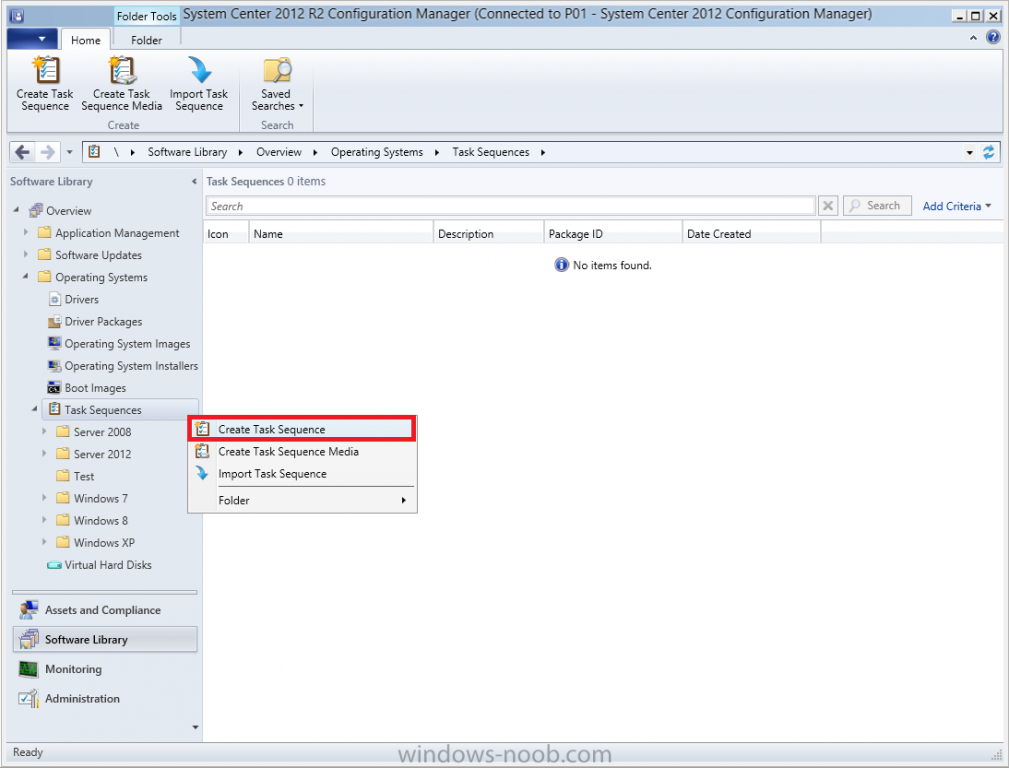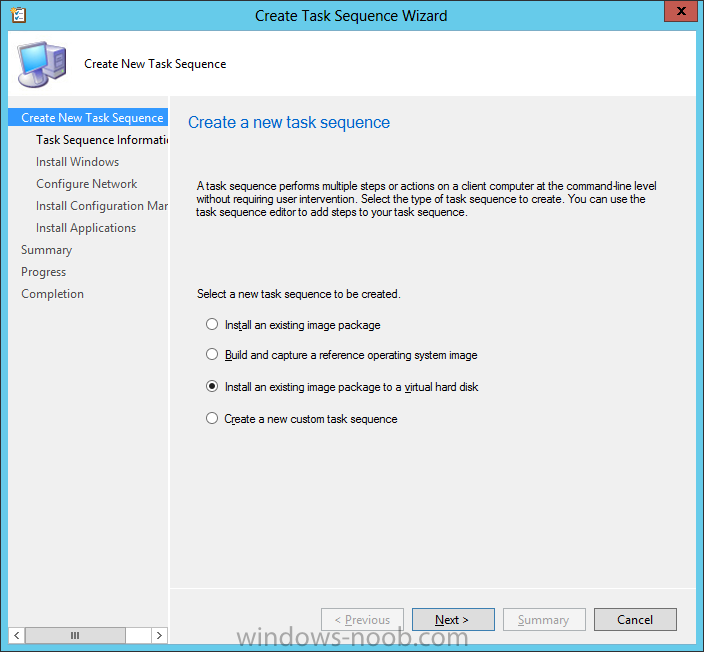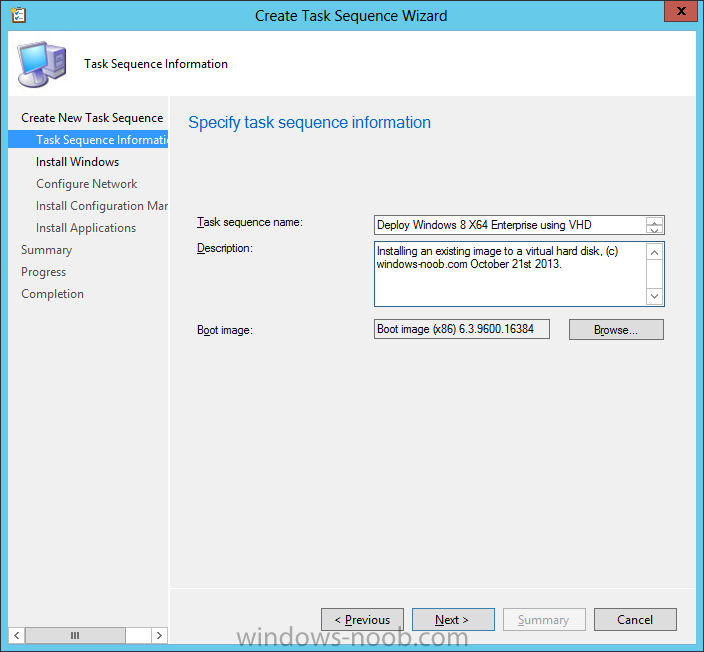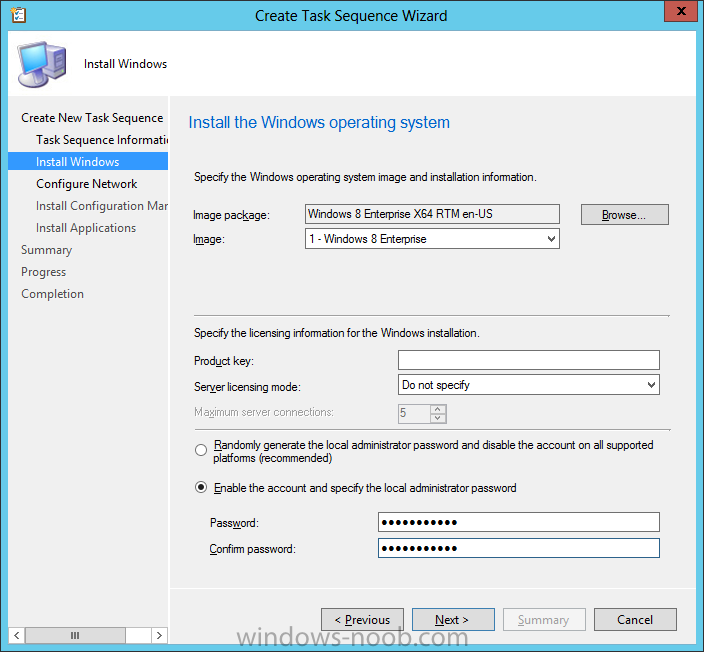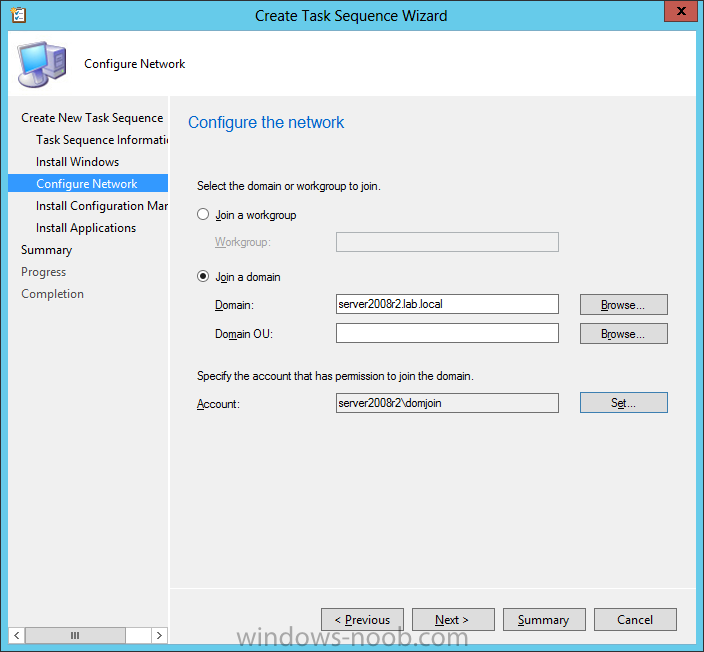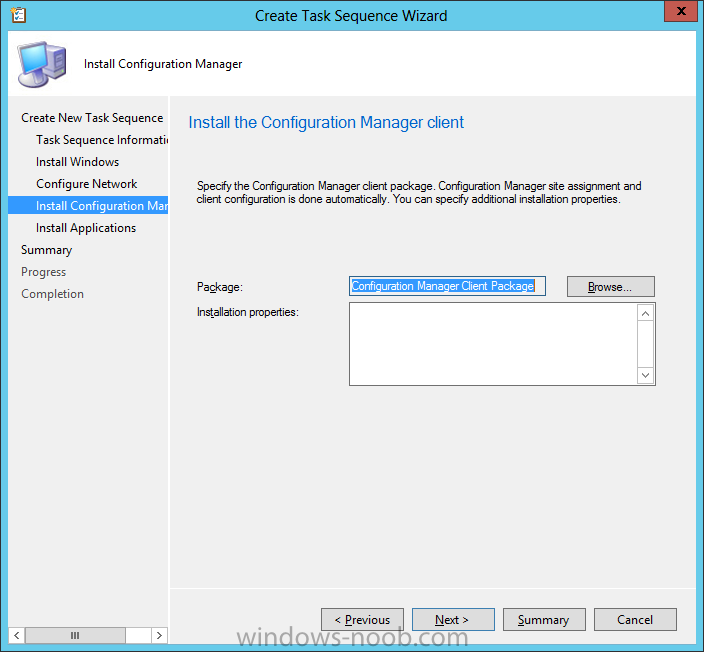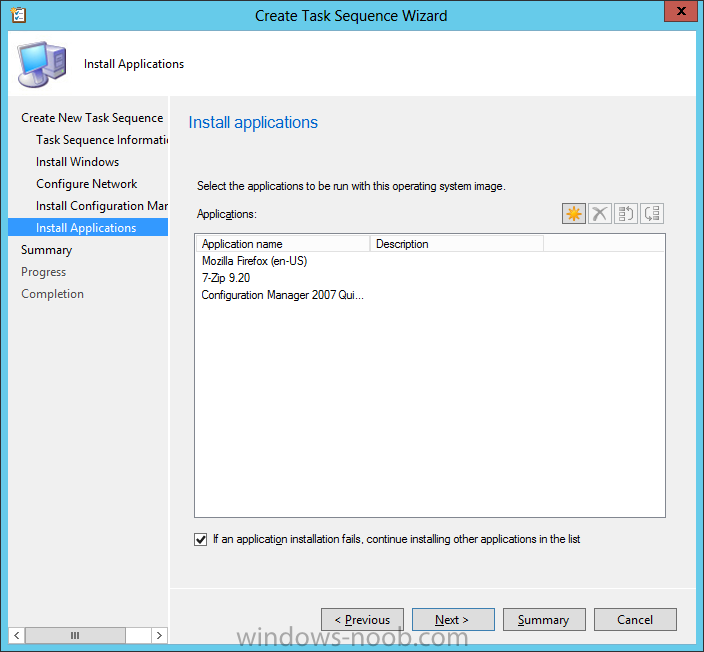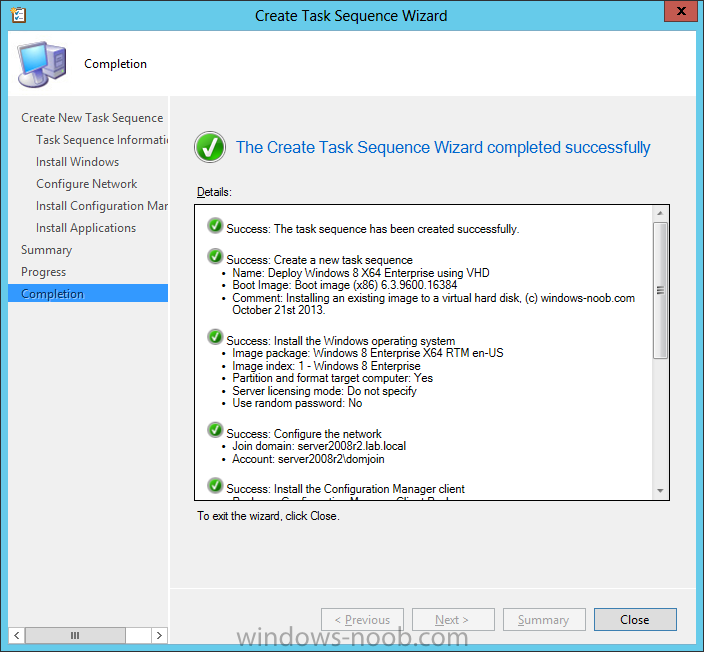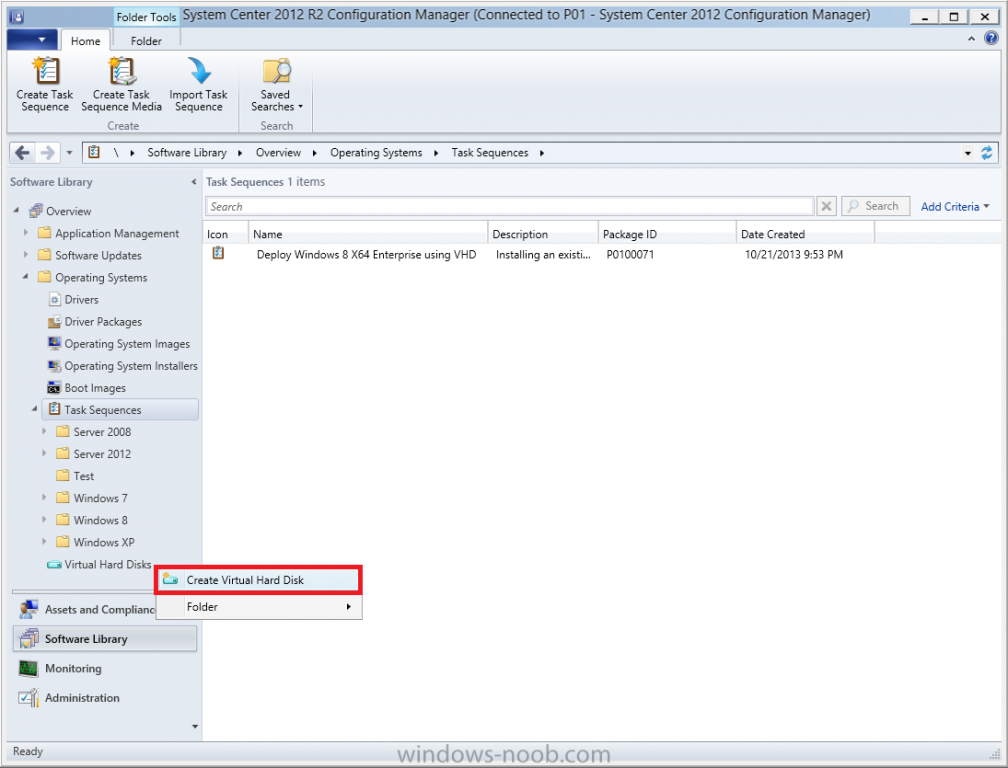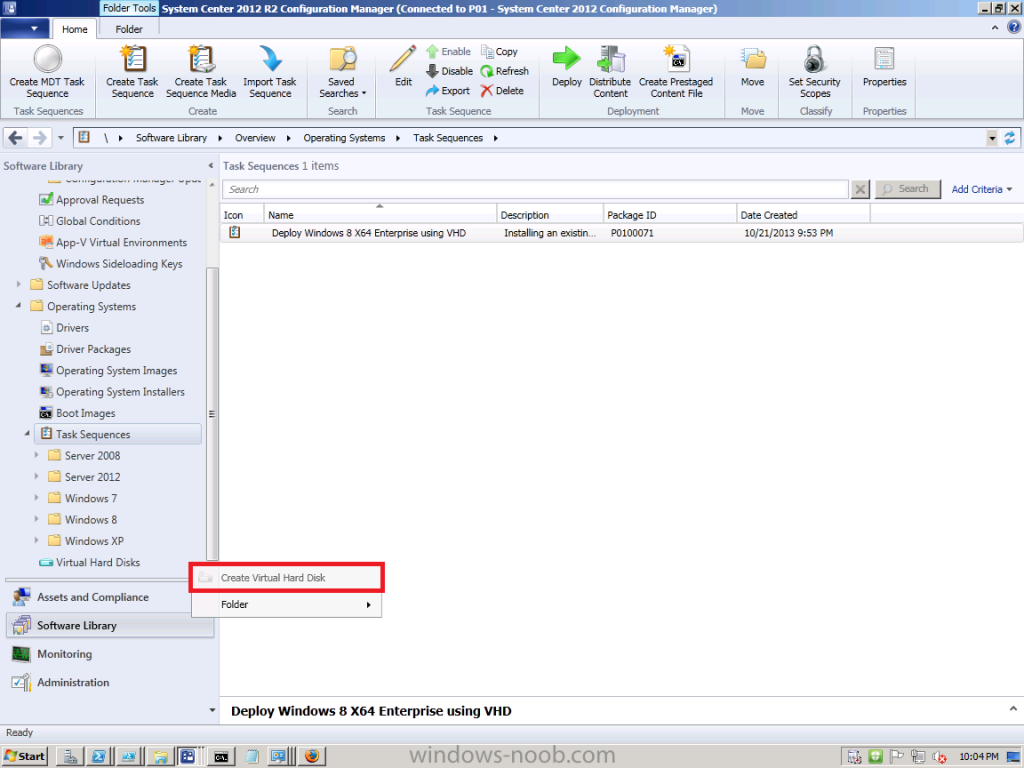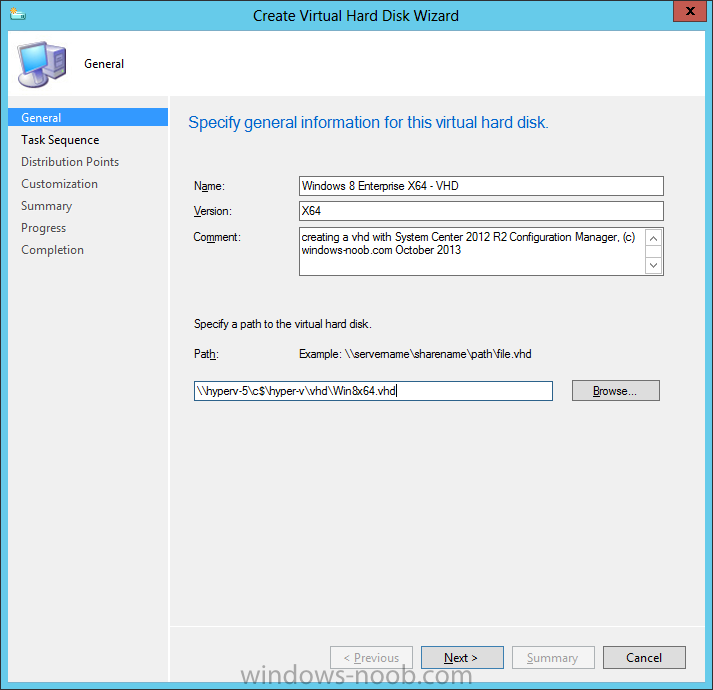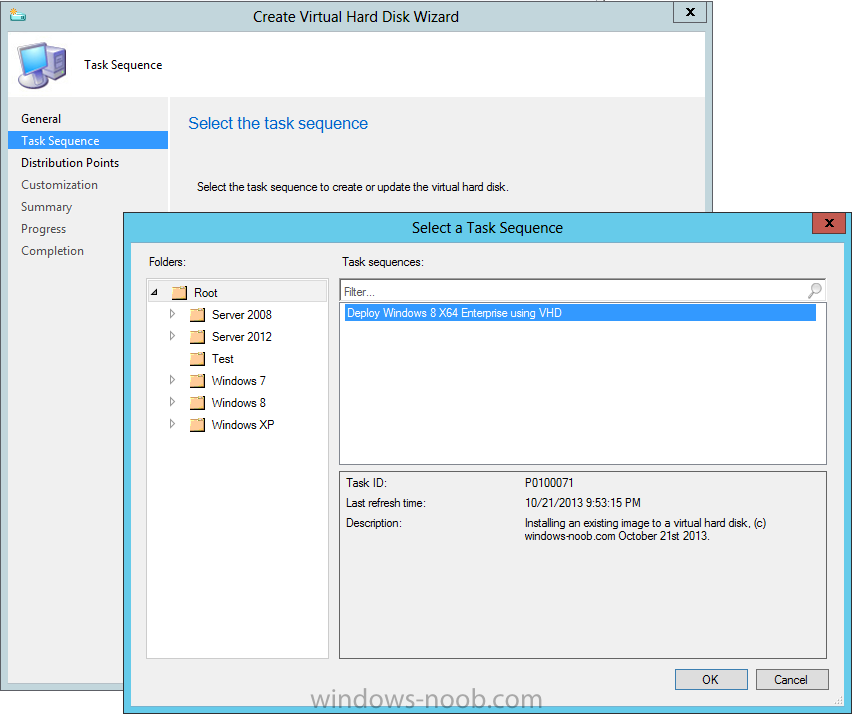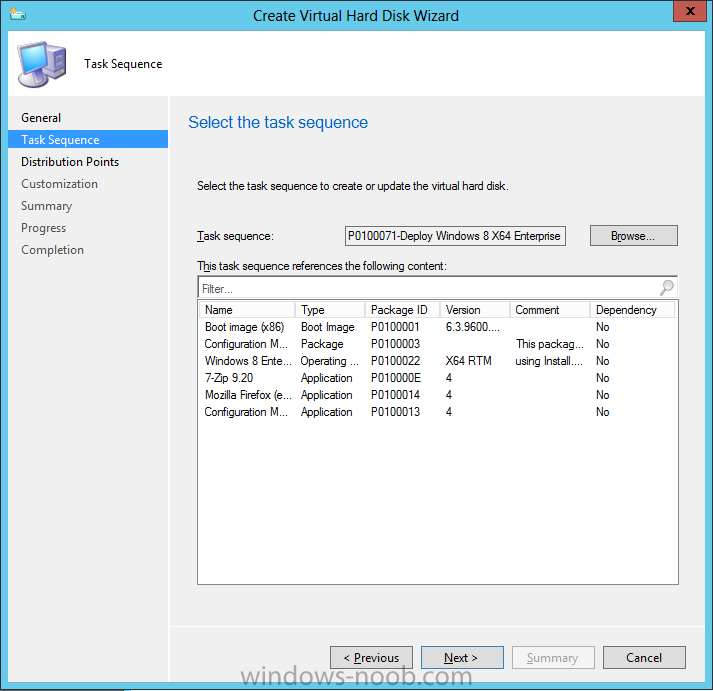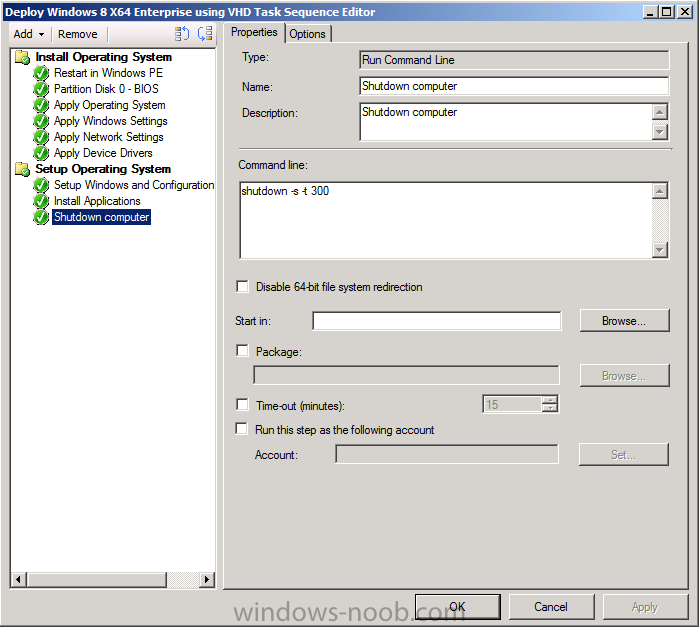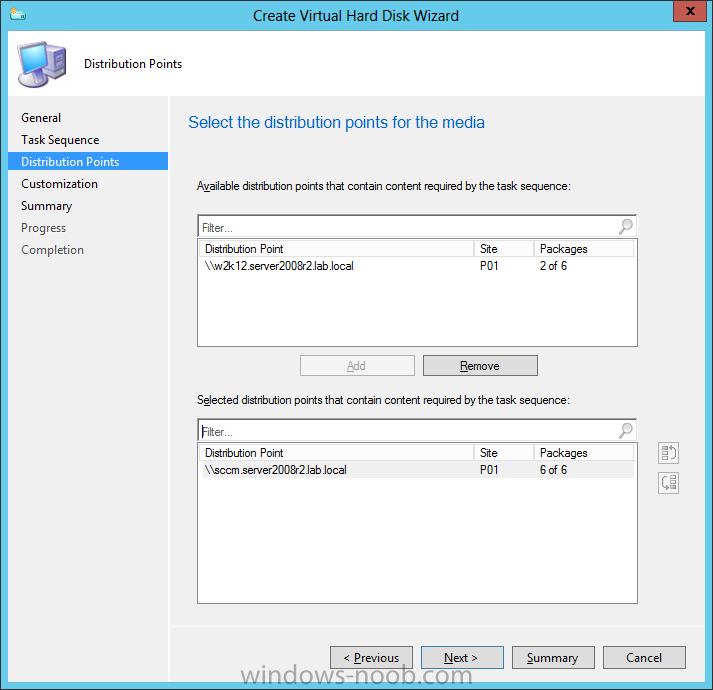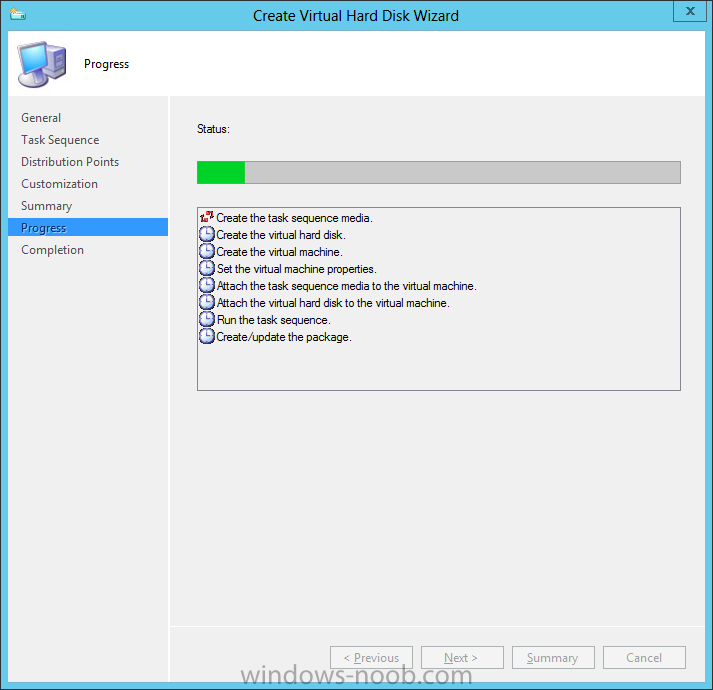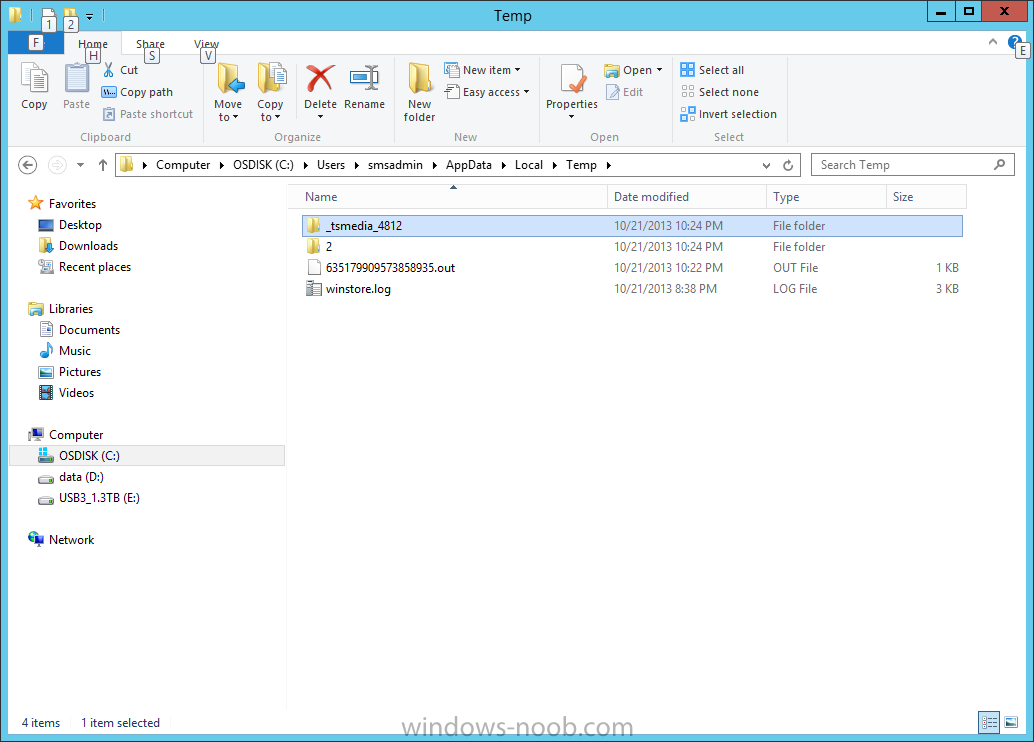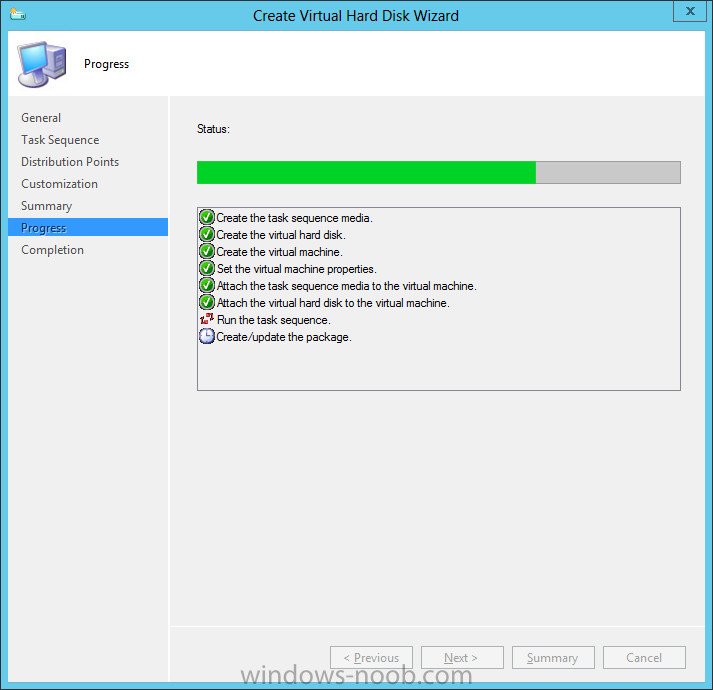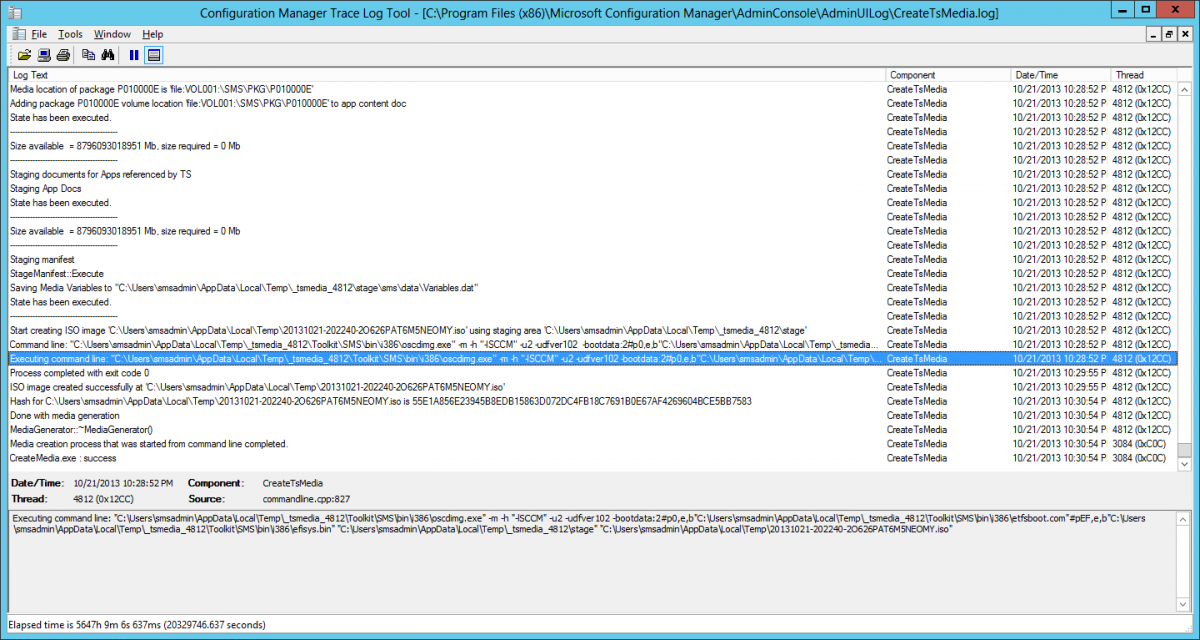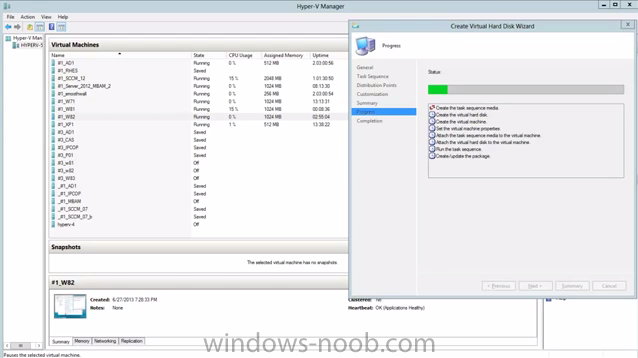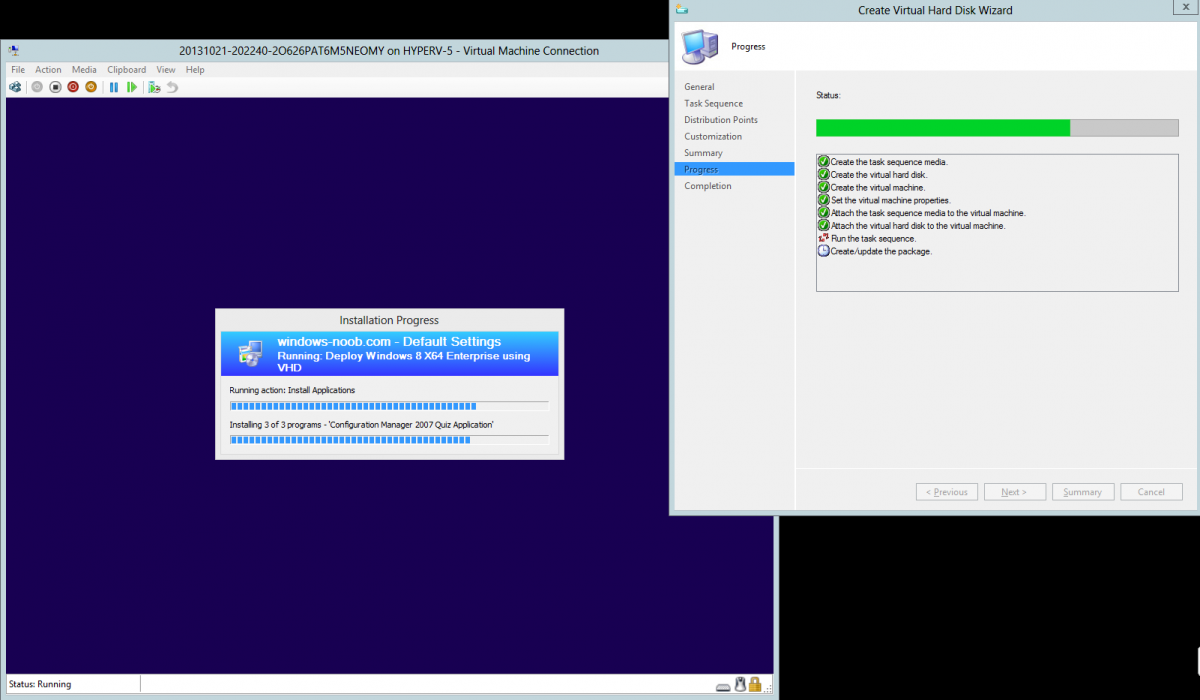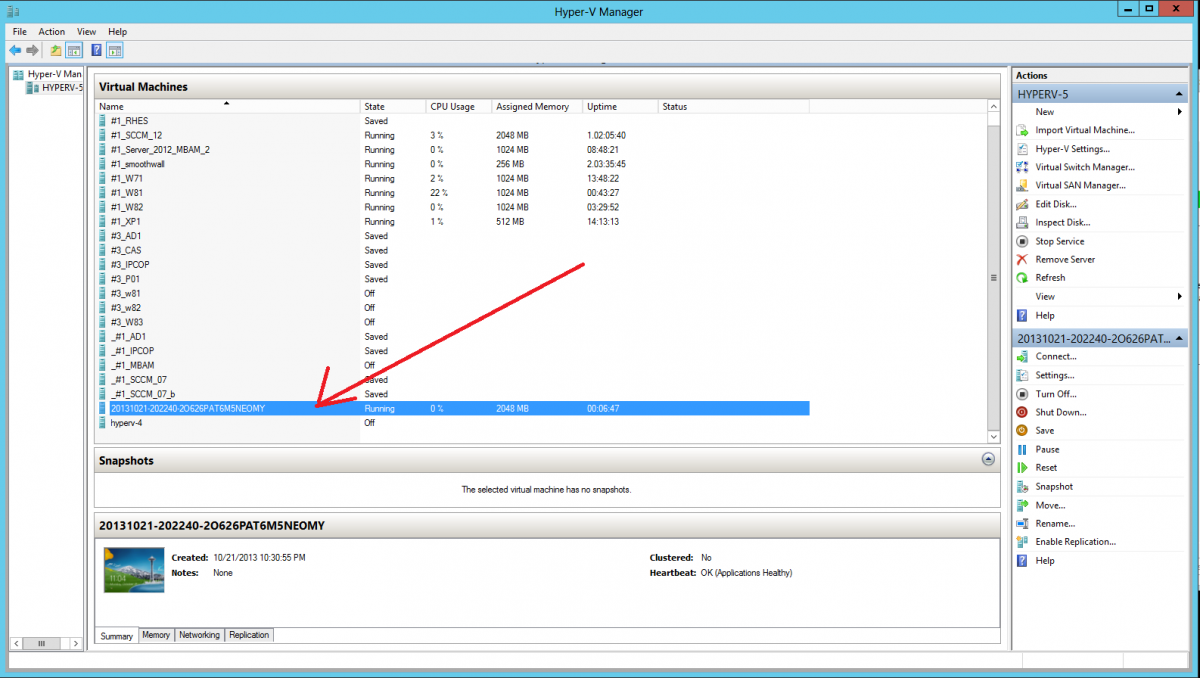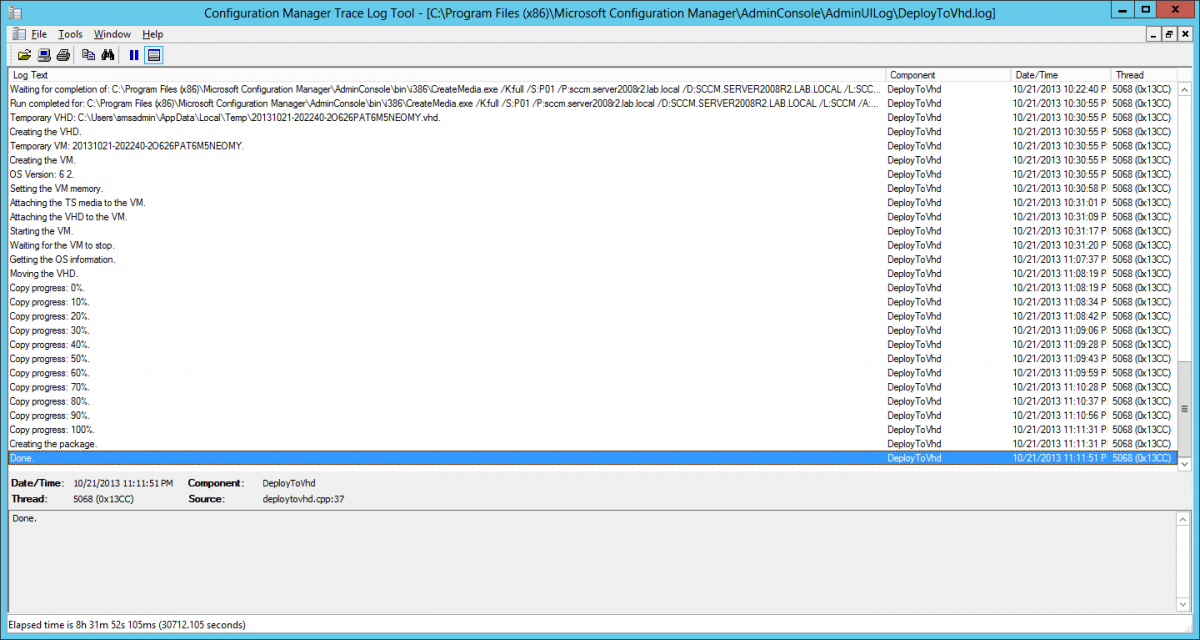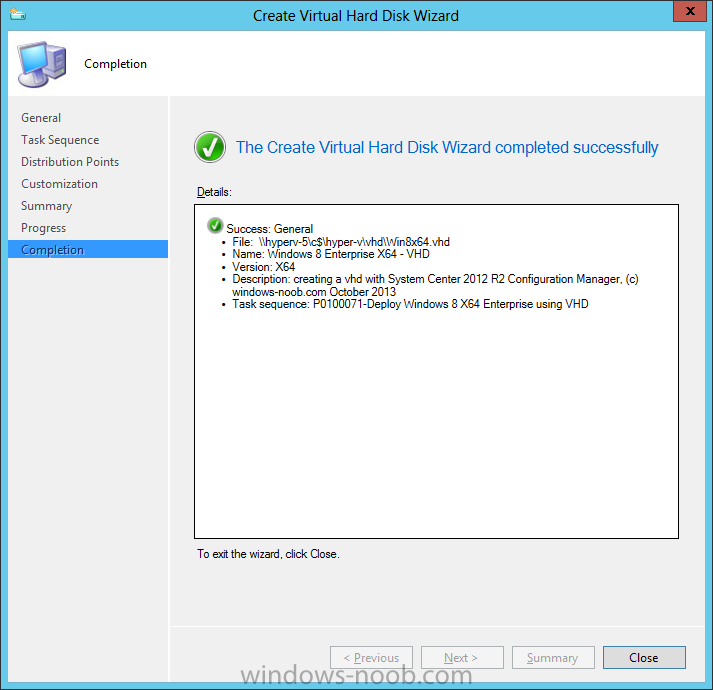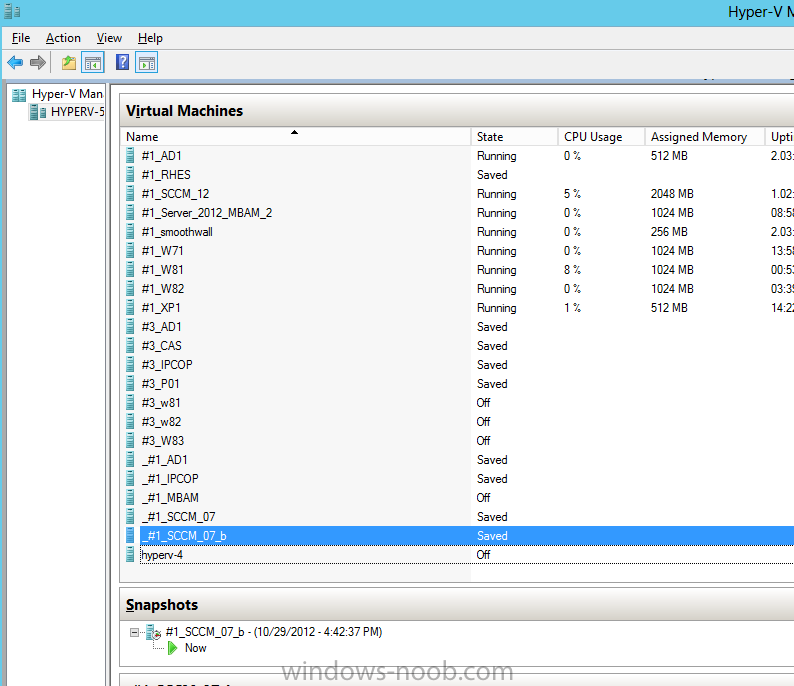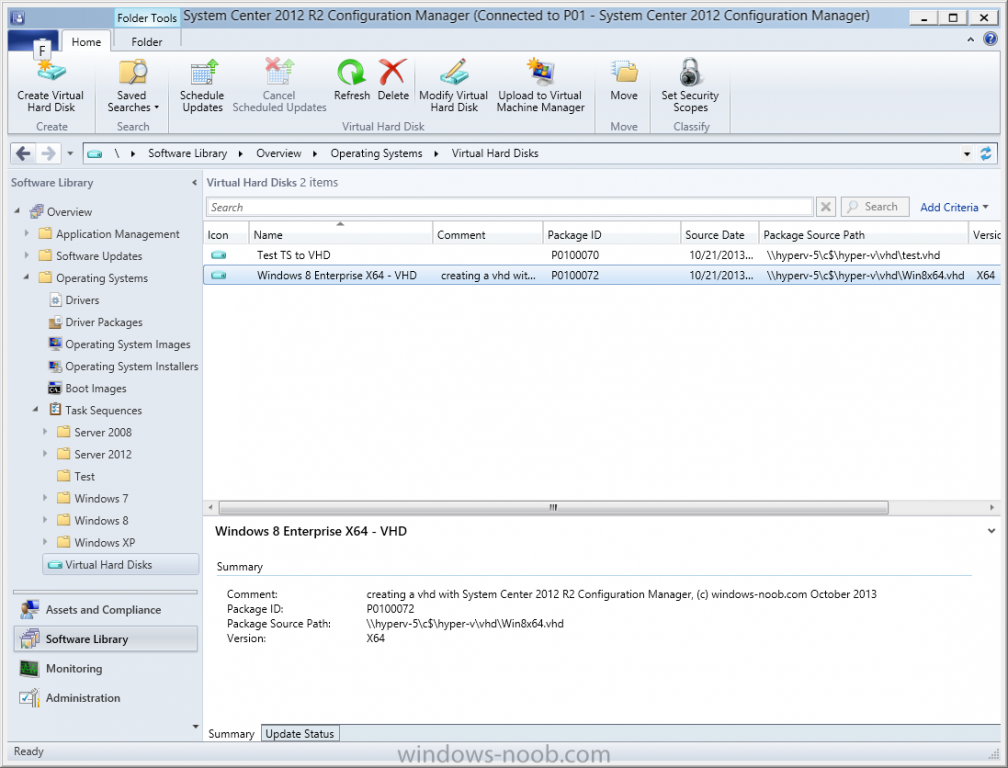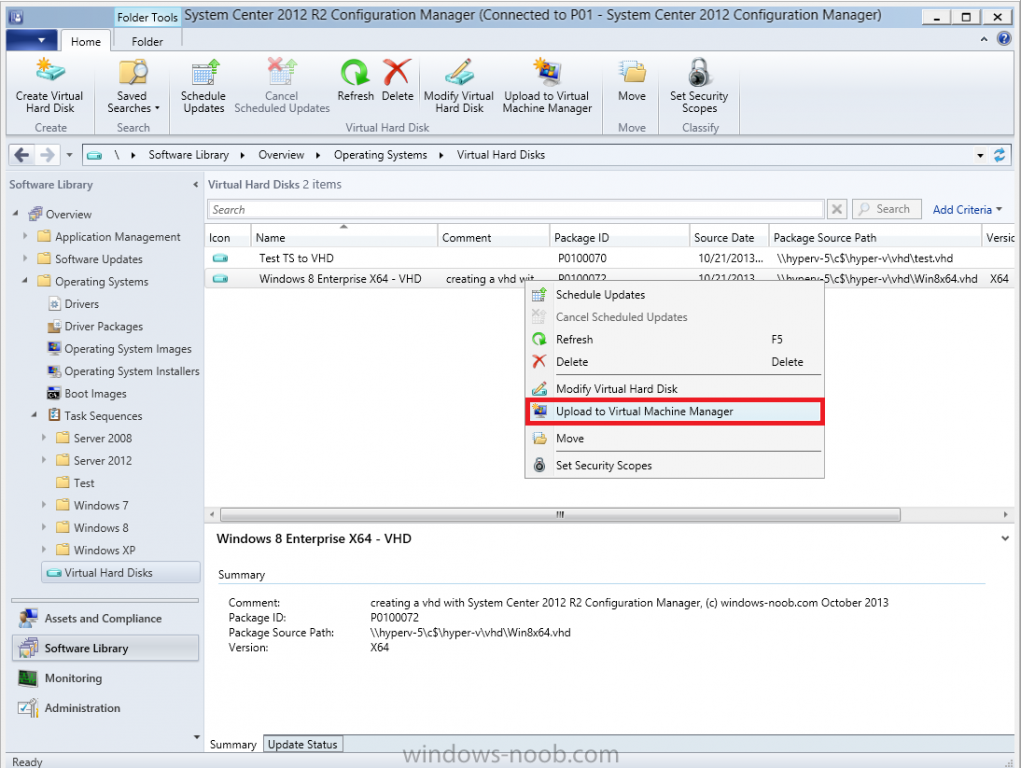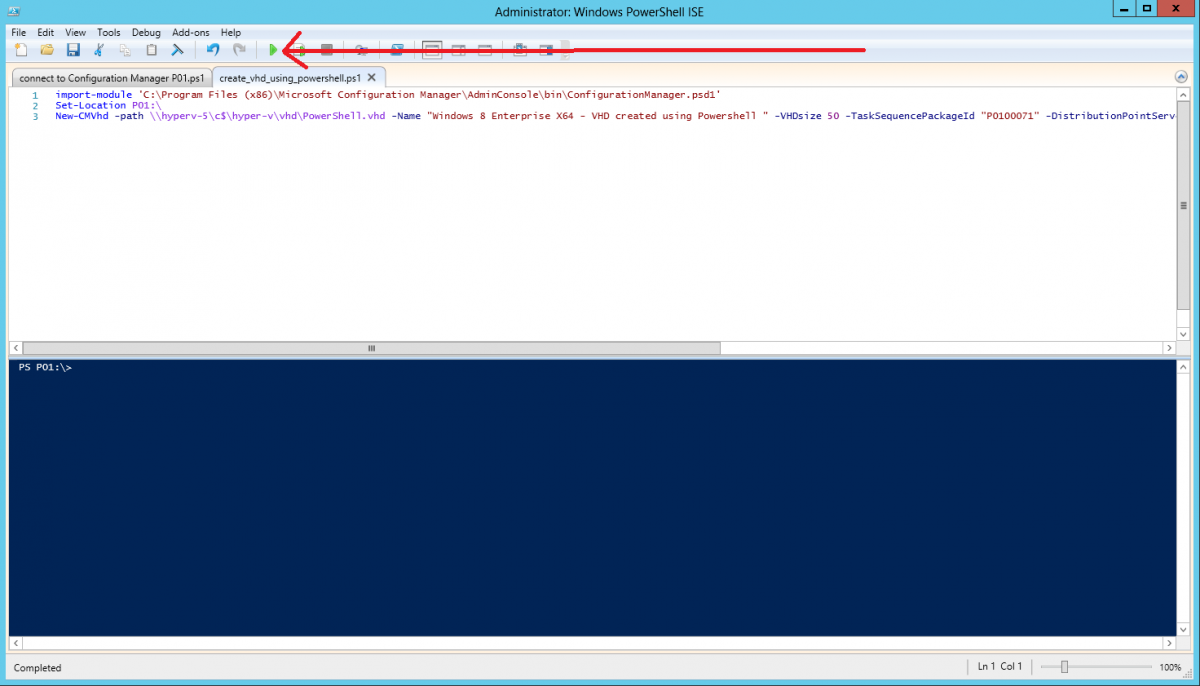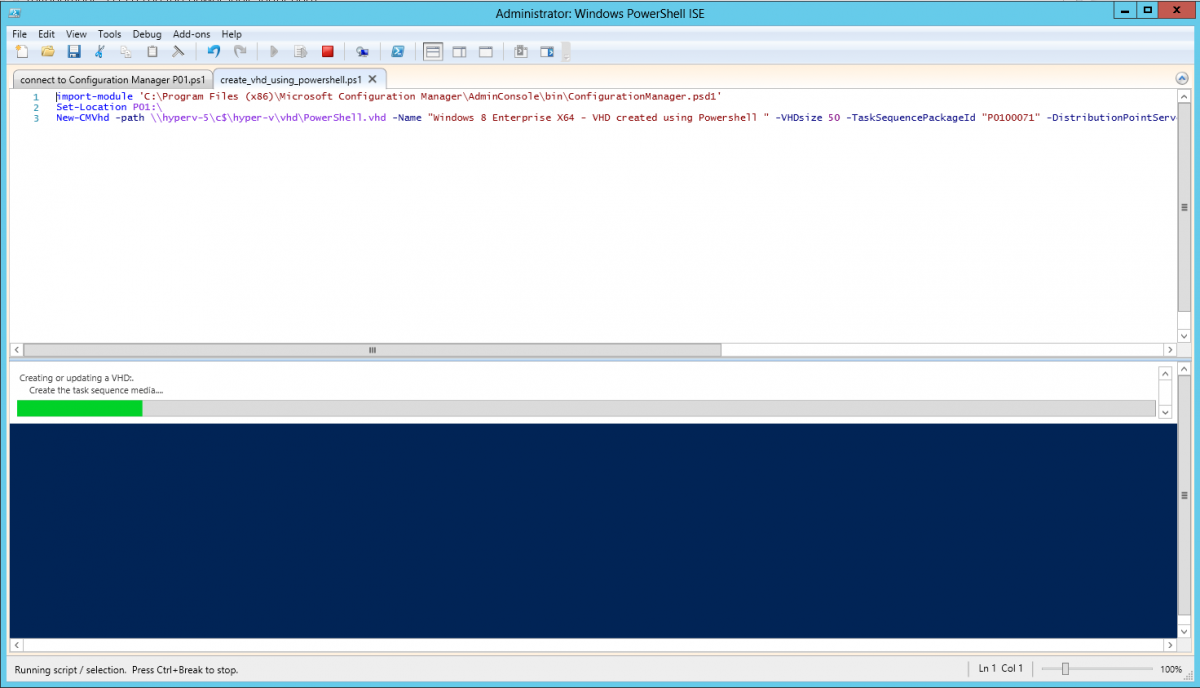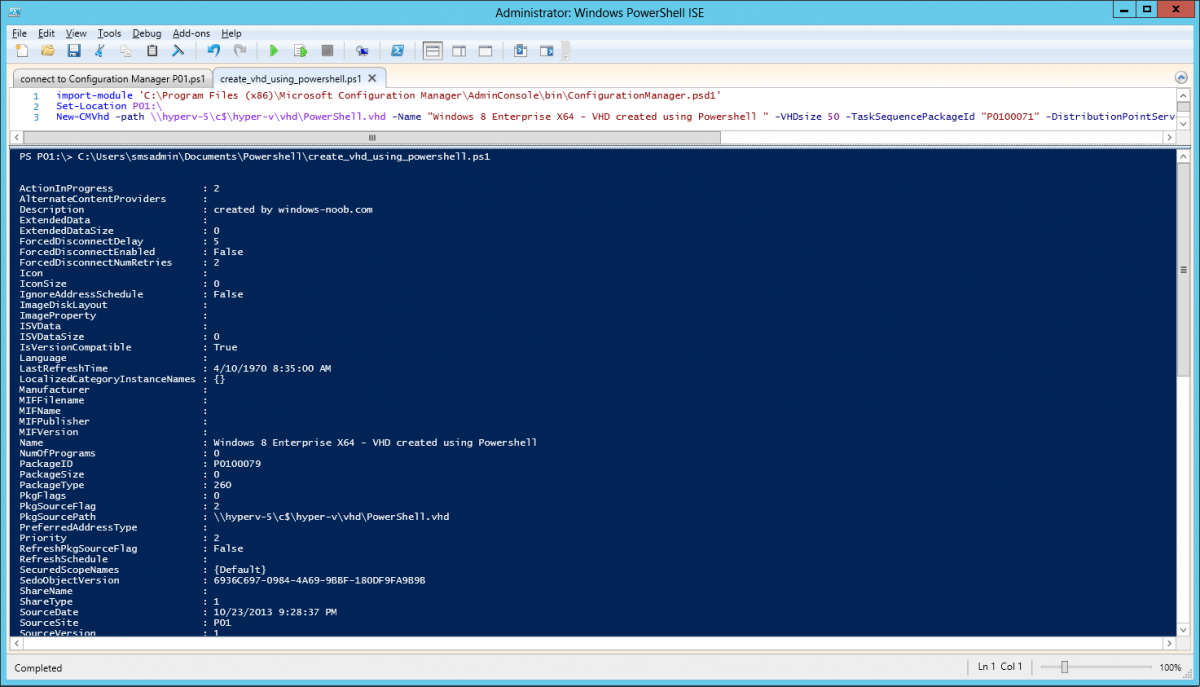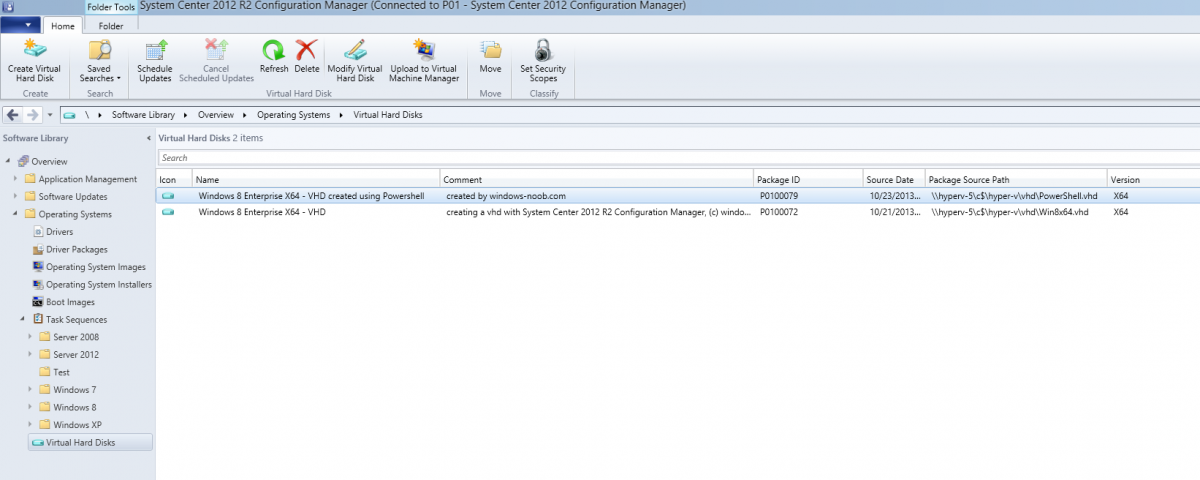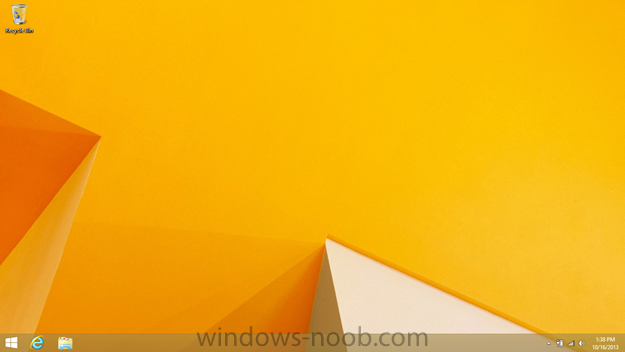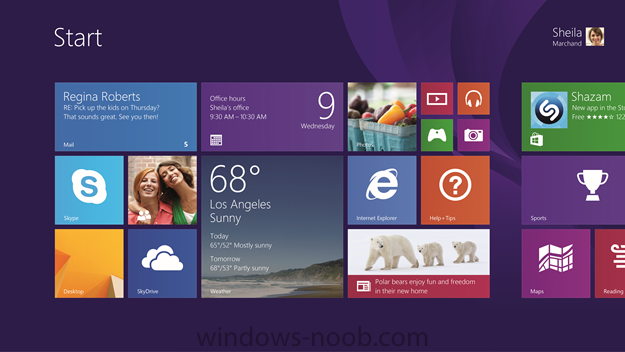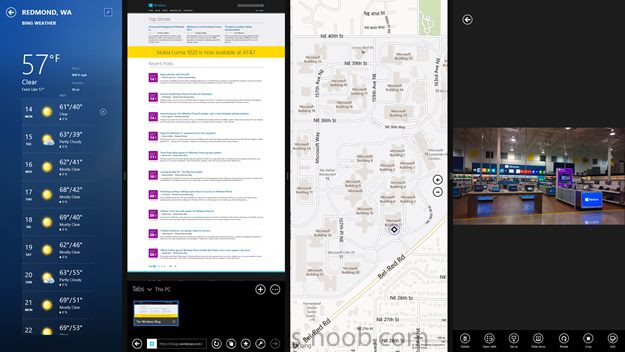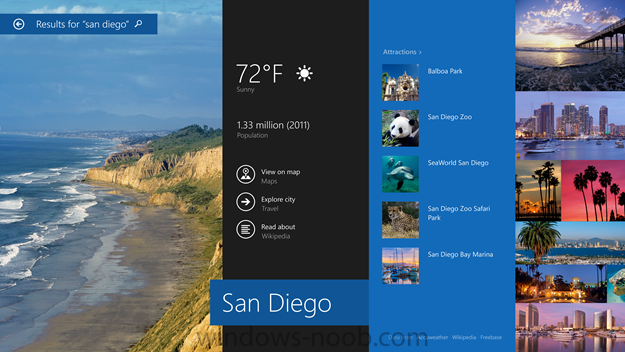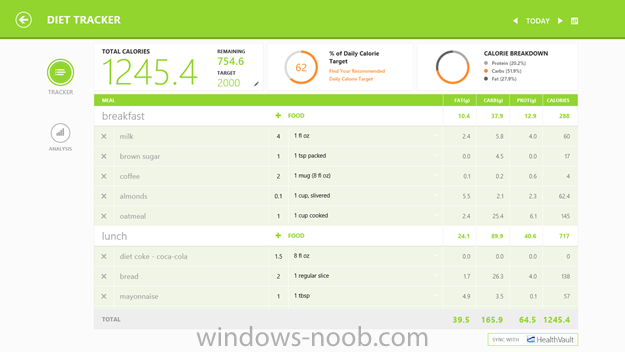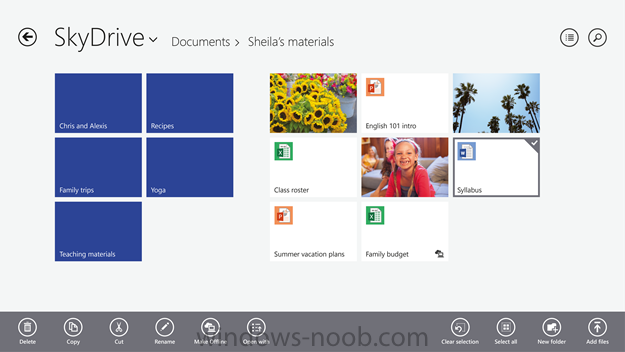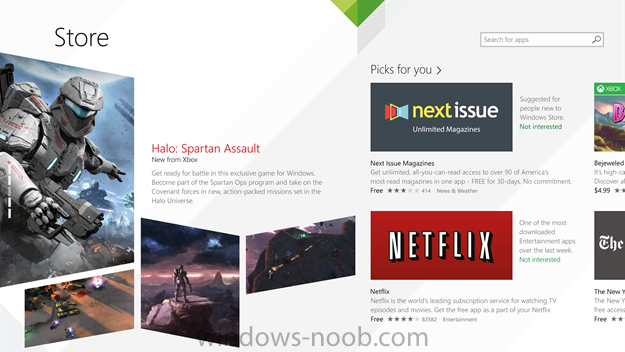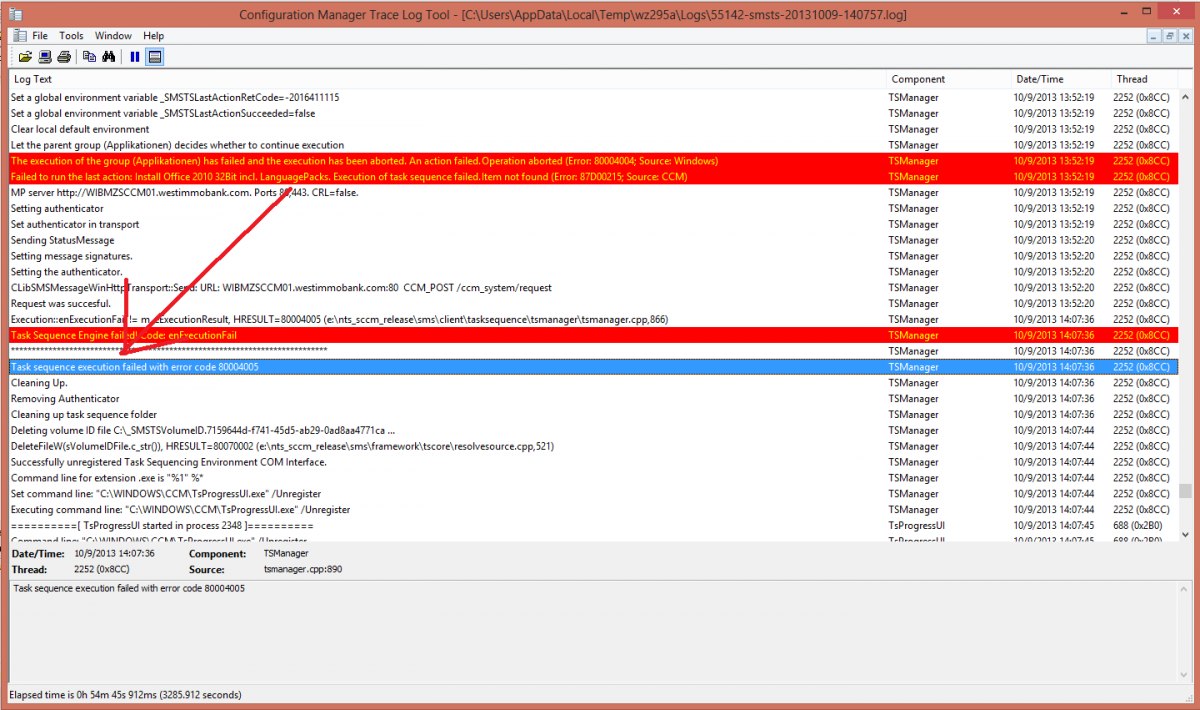-
Posts
9176 -
Joined
-
Last visited
-
Days Won
366
Everything posted by anyweb
-
Introduction Microsoft released System Center 2012 R2 Configuration Manager on October 18th, 2013 as planned (General Availability) and now we all have the ability to test the new features in the finished product. I've installed it in my lab and wanted to test the New operating system deployment features, one of which is the ability to create a VHD from a task sequence right from the Configuration Manager console. Before getting started however you'll need to have at least one host capable of running HyperV (such as Windows 8, Windows 8.1, Windows Server 2008R2, Windows Server 2012, Windows Server 2012R2) with the System Center 2012 Configuration Manager console installed. Tip: You'll need System Center 2012 R2 Configuration Manager installed, here's a step by step guide to get your started. Step 1. Create a new task sequence Note: Perform the following on any computer with the System Center 2012 R2 Configuration Manager AdminConsole installed as SMSAdmin. Open the Admin console, expand Software Library, Operating System Deployment and right click on Task Sequences, choose Create Task Sequence. choose the third option, install an existing image to a virtual hard disk choose a suitable name for your task sequence and select a boot image In this task sequence I am deploying Windows 8 X64 Enterprise using the Install.wim file from the DVD, I also select to enable the Administrator account and I specify a password select to Join a domain and fill in appropriate domain join credentials and install the configuration manager client, you can add switches here if needed and select to install some applications if you wish click next through to the completion message You can now edit the task sequence if you wish and add/remove steps, note the last step is a shutdown command, this is a special step and is 'looked for' by the wizard later on so that it knows the task sequence is complete and to generate the VHD. Step 2. Create a Virtual Hard Disk Note: Perform the following on a HyperV host computer with the System Center 2012 R2 Configuration Manager AdminConsole installed as SMSAdmin. Method #1 - Do it using the AdminConsole In the Admin console Expand the Task Sequences node in Operating System Deployment and right click on Virtual Hard Disks. If this is greyed out it's because you are not running the console on a Hyperv Enabled host (I've tested it on Server 2012 running Hyperv with the R2 admin console installed). To make it clear, i'm including two screenshots of the same action, one on a hyperV host, the other is an adminconsole with no hyperV hosts locally installed. Note: the below screenshot is on a host without hyperv installed or enabled. Note how the Create Virtual Hard Disk action is greyed out. Note: the below screenshot is on a hyperv host Now that we've started the create virtual hard disk wizard, fill in some details about our virtual hard disk. next select our task sequence that we created in Step 1 and depending on how complicated the task sequence was it will take some time to generate a list of task sequence referenced content select a distribution point that has all the packages on it (XX of XX) and click your way through the wizard, at this point you'll see be prompted to allow access to your host computer (to create the file) and shortly after the magic begins The task sequence media creation is logged in the CreateTSMedia.log file located on the hyperv host running the adminconsole (Typically C:\Program Files (x86)\Microsoft Configuration Manager\AdminConsole\AdminUILog) The user you are logged in as will have it's AppData\Local\Temp dir used as a temporary scratch space, so make sure you have lots of space if needed or use the link at the bottom of this page to change your TMP environment variables to point to a drive with more free space. and off it goes creating the virtual hard disk (look at this video to see the process in more detail, watch above the hyperv4 vm to see the new virtual machine being created, this video has no audio yet, it's coming hopefully if i get time...) This involves, automatically creating a temporary virtual machine in hyperV, starting it automatically, starting the task sequence automatically and finally sealing the VHD file which can then be seen in the configuration manager console. Below you can see the temporary virtual machine in hyperv shortly before the VHD is created (task sequence is complete) The temporary virtual machine continues to run the task sequence, eventually installing our applications once complete the Virtual machine shutsdown and the VHD copying starts, you can now monitor the DeploytoVHD.log file (in C:\Program Files (x86)\Microsoft Configuration Manager\AdminConsole\AdminUILog) When the logfile confirms the process is done then you can assume that the wizard is also complete...and it is... :-) and you'll notice that the temporary virtual machine is gone and clicking on Virtual Hard Disks in the Admin console will list our newly created VHD file, success ! at which point you can modify the VHD (by choosing that action in the ribbon or via right click) or just upload it to Virtual Machine Manager. Method #2 - Do it using PowerShell Start PowerShell ISE (PowerShell Integrated Scripting Environment) as Administrator and paste in the following code import-module 'C:\Program Files (x86)\Microsoft Configuration Manager\AdminConsole\bin\ConfigurationManager.psd1' Set-Location P01:\ New-CMVhd -path \\hyperv-5\c$\hyper-v\vhd\PowerShell.vhd -Name "Windows 8 Enterprise X64 - VHD created using Powershell " -VHDsize 50 -TaskSequencePackageId "P0100071" -DistributionPointServerNames SCCM.server2008r2.lab.local -Version "X64" -Description "created by windows-noob.com" The first two lines simply import the configuration manager powershell module and then set your path to your primary server P01. The New-CMvhd cmdlet is a new cmdlet in R2 and it is used to create the VHD using powershell. In the above, the -TaskSequencePackageId value is the PackageID of your task sequence, make sure to set the appropriate values in the New-CMvhd command to suit your environment (for example your server share). Click on the Green arrow to run your powershell script and off it goes ! and after some VHD creation...............job done ! and our VHD appears in the console not too bad eh ? cheers niall Related reading What’s New in System Center 2012 R2 Configuration Manager - http://technet.microsoft.com/library/dn236351.aspx How an I install System Center 2012 R2 Configuration Manager - How can I install System Center 2012 R2 Configuration Manager ? Changing the TMP variable for OSD media creation - http://blogs.technet.com/b/configmgrteam/archive/2013/07/16/customizing-the-temporary-location-for-osd-media-creation.aspx Windows PowerShell Integrated Scripting Environment (ISE) - http://technet.microsoft.com/en-us/library/dd819514.aspx using System Center 2012 Configuration Manager - Part 12. Connecting PowerShell and Building a reference image of Windows 8 with .Net 3.5 Configuration Manager SP1 Cmdlet Reference - http://technet.microsoft.com/en-us/library/jj821831.aspx
-
you can use web services (maik koster) to do that or create a run book in orchestrator.
-
Less than a year ago we were preparing to launch Windows 8, which introduced our vision of highly personalized mobile computing. And here we are today announcing the global availability of Windows 8.1. Windows 8.1 demonstrates our commitment to continuously improving the product to create a richer customer experience. We are excited to have customers start updating their devices today and getting to experience new Windows devices this holiday season. Windows 8.1 brings a variety of new features and improvements to Windows 8 that we think people will really enjoy. We listened to your feedback and are delivering many of the improvements you asked for. If you are a consumer with a Windows 8 device, you can now download the free update to Windows 8.1 online through the Windows Store*. Please visit Windows.com for everything you need to know including how to get the update for your Windows 8 device. If you are a consumer on a device running Windows 7, Windows Vista, Windows XP, or the Windows 8.1 Preview – this page on Windows.com will detect your OS and provide you with all the information you need in order to get Windows 8.1 on your device. I also highly recommend reading our FAQ which answers many of the most common questions about getting Windows 8.1. Starting tomorrow October 18th, Windows 8.1 will also be available on new devices and as packaged DVD product at retail locations around the world. You can also click here to learn about the wide variety of new Windows devices available now and coming throughout the holiday season to find the one that best fits their needs, and their budget. To celebrate the new Windows, starting today for the next 8 days – we will pick 810 (see what we did there?) random winners per day who tweet and share their new Start screen after updating their Windows 8 device to Windows 8.1 with the #MyStart hashtag. You’ve heard us (and me) talk a lot about the new features in Windows 8.1 since the Build conference last June but I think it’s worth reiterating the awesomeness that Windows 8.1 brings to your device. Start the way you want. The Start screen in Windows 8.1 is more customizable than ever with new tile sizes, new background designs and colors – allowing you to make the Start screen on your device unique and personal to you (you should see some of the color combinations I’ve come up with for my Start screen!). You can also choose how you start your Windows experience – at the Start screen or the desktop. The Start button is back. And there is an improved Apps view that allows you to see all your apps the way you want. Multi-tasking is even better in Windows 8.1 – you can now have up to four apps side by side with flexible windows sizing for each app on the screen. At a minimum, I usually have 3 apps snapped side by side on my devices doing various things like email, listening to music and browsing the web. We have also improved multi-monitor support in Windows 8.1 allowing users to view their desktop or apps from the Windows Store on any or all their monitors. Bing Smart Search is the easiest way to find what you are looking for and to get things done. Built for touch, swipe or type from the Start screen and Smart Search will find what you need – whether it’s a document on your PC, a photo album in the cloud, your favorite app, or a website. Windows 8.1 comes with new and improved Microsoft apps and services – available right out of the box and right from your Start screen. Skype is there for instant messaging and catching up with friends and family. We’ve updated the Mail app (well, more like over-hauled) to make email easier – for both personal and email and work email. Two new Bing apps are introduced in Windows 8.1 called Food & Drink and Health & Fitness along with updates to the News, Weather, Finance, Travel and Sports apps. Xbox Music has received a big update for Windows 8.1, and you can watch TV and movies with Xbox Video. And Windows 8.1 comes with Internet Explorer 11which is optimized for touch and brings speed boosts and synchronized browsing history, favorites, and settings across all of your Windows 8.1 devices. Speaking of synchronizing – Windows 8.1 also comes with deep and improved cloud integration with SkyDrive. Your files are always accessible across all your devices. With SkyDrive smart files, you can create, edit, save and share files anywhere, anytime and your files are always with you, both on and offline. And the Windows Store has been redesigned in Windows 8.1. With the “New & Rising” section it is now easier to stay on top of the hottest and newest apps to hit the Windows Store. Plus, the Windows Store has a live tile too! The Windows Store will also now provide you with personalized recommendations – powered by Bing. And apps are now updated from the Windows Store automatically by default so you will always have the best and newest versions of your apps. Look for new and updated apps including Adobe Photoshop Express, Box, Evernote, Facebook, Hulu Plus, Netflix, and NOOK, for Windows 8.1. And more to come! Windows 8.1 will also bring some very innovative new devices for both consumers and businesses from tablets and 2-in-1s with a perfect mix of mobility and productivity, to new laptops, All-in-Ones and specialized industry devices.Windows 8.1 brings the widest selection of designs at every price point. I’ll be blogging more about many of these devices over the next few weeks as they become available, so you can find and experience a device that is truly an extension of you. Windows 8.1 represents collaboration across the entire company. Over the last three days, we’ve featured guest blog posts from our friends at Skype, Xbox, Bing, SkyDrive, and Internet Explorer that discusses in the connected experience that Windows 8.1 brings together. And now you can enjoy the results of this work today. So get your device updated! And be sure to share those Start screens. *Internet access required; fees may apply. via > http://blogs.windows.com/windows/b/bloggingwindows/archive/2013/10/17/windows-8-1-now-available.aspx
-
Microsoft is making Windows 8.1 commercially available over the next day-plus (depending on your time zone). Unsurprisingly, this milestone leads many Microsoft watchers, partners and customers to wonder what will be coming next. Again, unsurprisingly, Microsoft officials aren't talking about what will be the follow-on to Windows 8.1, codenamed "Blue." But that doesn't mean things are at a standstill. Here's what I'm hearing from my sources. As I've blogged before, I've heard the Windows team will be releasing a Spring 2014 update to Windows 8.1 that will coincide with the release of Windows Phone Blue. (Yes, I am still hearing Windows Phone Blue, which may be called Windows Phone 8.1, is still a Spring 2014 thing.) Some believe Microsoft will also be releasing a bigger new version of Windows in the Fall of 2014, about a year after Windows 8.1. I'm hearing from one of my trusted sources who has a good accuracy rate on Windows rumors that this is looking less and less likely. There's a lot in flux inside the new, unified Operating System Group at Microsoft, headed by Terry Myerson. Supposedly, from what I'm hearing, the OSG team is rethinking priorities, workflow and just about everything else when it comes to Windows, Windows Phone and the Xbox operating systems, going forward. Right now — and this may change — the idea is to deliver a "major" release of "Windows" in the Spring of 2015. My aforementioned source says this major release will be a kind of hybrid that will bring the current Windows and Windows Phone OSes closer together. This is most likely when the rumored unified Windows and Windows Phone Store will debut. (There could be a unified developer portal, allowing developers to submit apps for both platforms before the actual store materializes, I'm hearing.) Right now, Microsoft has two ARM-based Windows operating systems: The Windows Phone OS and the Windows RT OS. The thinking is these will be one by Spring 2015. Because it tends to be easier to take a "smaller" OS and add to it than to take a larger one and remove features from it, it's likely that the Windows Phone OS is the one on top of which the new operating systems group will build. The recent rumor (courtesy of Windows SuperSite's Paul Thurrott) about the Windows Phone OS being modified to support 7 to 10-inch screen sizes makes sense in this context. It wouldn't surprise me if by 2015 Microsoft calls whatever is powering smartphones, phablets and tablets plain-old Windows, given the interfaces, the development platforms and the core operating systems will continue to align further. If my tipster is correct, Spring — which means calendar Q2 or so for those not in our hemisphere — is looking like the new preferred time for bigger OS releases from Microsoft, at least in the near term. Again, to be clear, this is all rumor (though a well-sourced one) at this point. Lots of things may change between now and Spring 2015. via Zdnet > http://www.zdnet.com/what-comes-next-after-windows-8-1-7000022034/
-
SAN DIEGO, Oct. 16, 2013 /PRNewswire/ -- Today Cireson, a leading force in the Microsoft System Center space, unveils yet another much anticipated app. This new release integrates with the Microsoft Outlook email client and is the first integration app of its kind. For Service Manager users, this means that direct syncing can occur between Outlook and System Center, allowing for seamless management of day-to-day activities. The new app also provides the ability to create, view, edit, and complete various incidents, changes, problems, activities, and service requests with greater ease than ever before. Delivering such a full range of expanded capabilities, Cireson apps continue to forge a path that encourages intuitive, simple, and smart solutions. This recent addition to the company's 15 other apps further solidifies Cireson's commitment to pioneering development and forward thinking on all things considered System Center. (Logo: http://photos.prnewswire.com/prnh/20131016/PH97159LOGO ) The following features represent a few of the main Outlook Console app benefits: Direct SCSM integration within Outlook to manage any day-to-day Work Item activities Ability to create, view, edit, and complete Incidents, Problems, Changes, Service Requests and Activities Create any Work Item from an e-mail and add emails to any Work Item View all Work Items assigned to you Support for Outlook 2010 and Outlook 2013 Commenting on this exciting new release, Managing Consultant at INOVATIV and seven-year System Center MVP Maarten Goet reveals, "This particular app has been, without question, the most requested app from our customer base. The Outlook Console opens a new chapter for users. It changes the way people interact with Service Manager, and as a result, redefines ease of use and productivity in the ways that matter most." Continuing the trend of converting valuable client input into real life System Center enhancements, Cireson has once again created a tangible, much needed solution for users who love to benefit from industry leading products. Not only will the Outlook Console complement the strength of the HTML 5 Cireson Analyst Web Console, it will also allow customers to seamlessly interact with SCSM processes in order to support overarching business from the most used daily pivot point in every user's life - Microsoft Outlook. For further information on the new Outlook Console, visit www.Cireson.com for videos, features, and more. About Cireson Cireson was founded on a simple, powerful idea: to be the forward thinkers on all things surrounding Microsoft System Center. Pioneering a team of passionate, partner focused, and technically brilliant System Center experts, Cireson offers the absolute best in market leading apps, deployments, custom development, and training. For further information on Cireson and the market leading SCSM Asset Management and SCSM Analyst Web Console apps, visit www.cireson.com or find us @TeamCireson and at www.facebook.com/teamcireson. Contact: Jacqueline Lage (855) 871-1232 Email Read more news from Cireson. Disclaimer: The article is from a windows-noob recommends partner.
-
the bits from above are included in the below task sequence CM12 in a Lab - The CM12 BitLocker FrontEnd HTA
-

Getting error when refreshing xp to 7
anyweb replied to blah blah blah's question in Microsoft Deployment Toolkit (MDT)
try running diskpart on the virtual machine disk (or real hard disc) and create a primary partition, format it like so (in WinPE), warning this will wipe anything on the selected disk ! diskpart then clean cre par pri format fs=ntfs quick assign exit once done, reboot and try the task sequence again -
you can't, you'll need to import it into a test lab Configuration Manager environment and then copy the steps manually one by one into a new MDT task sequence.
-
i can see that windows is on D:, is that correct ? if you've hardcoded anything to run from C:\ then this might explain the failure.. however the command line looks ok the client.msi.log reveals... and then later... the errors pretty much explode after that point, so can you tell us a little bit more about how you are installing these systems and how did you capture/install the original os ?
-
An update is available to address issues that were discovered after the release of Cumulative Update 3 (CU3) for Microsoft System Center 2012 Configuration Manager Service Pack 1 (SP1). Issues that are fixed Note These issues do not affect Microsoft System Center 2012 R2 Configuration Manager. Issue 1 The SQL Update part of the Cumulative Update 3 installation fails when the date format on the instance of Microsoft SQL Server is defined in the DD/MM/YYYY format. Additionally, the CM12-SP1CU3-KB2882125-X64-ENU.log file contains entries that resemble the following: Msg 242, Level 16, State 3, Procedure #SP_CICategoryInstance_00065D65, Line 20 The conversion of a varchar data type to a datetime data type resulted in an out-of-range value. The statement has been terminated. Note The overall installation of the cumulative update is complete and has a warning status. Issue 2 The All Windows RT and All Windows RT 8.1 Preview entries should not appear in the supported platform list for new configuration items. Issue 3 Task sequences that contain Windows 8.1 as a condition on the Options tab generate an exception when they are changed or accessed. Details of the exception are displayed in text that resembles the following: System.Reflection.TargetInvocationException Exception has been thrown by the target of an invocation. you can get it here
-
Microsoft have posted the following update This update extends the Key Management Service (KMS) for Windows Vista, Windows Server 2008, Windows 7, Windows Server 2008 R2, Windows 8, and Windows Server 2012 to enable the enterprise licensing of Windows 8.1 and Windows Server 2012 R2. KMS provides support for the following KMS client activations: Windows Vista Windows Server 2008 Windows 7 Windows Server 2008 R2 Windows 8 Windows Server 2012 Windows 8.1 Windows Server 2012 R2 KMS uses a KMS host key to activate itself on a KMS host and to establish a local activation service in your environment. This update extends support for KMS to provide activation for Windows 8.1 and for Windows Server 2012 R2. Update information Microsoft Download CenterThe following files are available for download from the Microsoft Download Center: Operating system Update All supported x86-based versions of Windows Vista and of Windows Server 2008 Download the package now. All supported x64-based versions of Windows Vista and of Windows Server 2008 Download the package now. All supported IA-64-based versions of Windows Server 2008 Download the package now. All supported x86-based versions of Windows 7 Download the package now. All supported x64-based versions of Windows 7 Download the package now. All supported x64-based versions of Windows Server 2008 R2 Download the package now. All supported IA-64-based versions of WindowsServer2008 R2 Download the package now. All supported x86-based versions of Windows 8 Download the package now. All supported x64-based versions of Windows 8 Download the package now. All supported x64-based versions of Windows Server 2012 Download the package now. For more information about how to download Microsoft support files, click the following article number to view the article in the Microsoft Knowledge Base: 119591 How to obtain Microsoft support files from online services Microsoft scanned this file for viruses. Microsoft used the most current virus-detection software that was available on the date that the file was posted. The file is stored on security-enhanced servers that help prevent any unauthorized changes to the file. PrerequisitesTo apply this update, you must be running one of the following operating systems: Windows Vista Service Pack 2 Windows Server 2008 Service Pack 2 Windows 7 Service Pack 1 Windows Server 2008 R2 Service Pack 1 Windows 8 Windows Server 2012 Installation instructionsIf you have a KMS host that is running Windows Vista, Windows Server 2008, Windows 7, Windows Server 2008 R2, Windows 8, or Windows Server 2012, follow these steps to perform an upgrade: Install this update (update 2885698). Restart the computer when you are prompted to do so. To install a new KMS host key for Windows 8.1 activation or for Windows Server 2012 R2 activation, run the following command: cscript %windir%\system32\slmgr.vbs /ipk <KMS host key> Note In this command, "<KMS host key>" is a placeholder for the new KMS host key for Windows 8.1 activation or for Windows Server 2012 R2 activation. Important Every KMS host key is associated with a group of Windows editions. Additionally, a KMS host key that is associated with Windows client operating systems cannot be installed on Windows server operating systems, and vice-versa. This is true for all Windows operating systems except for Windows Server 2003. If you install a KMS host key on a Windows operating system that is not associated with that host key, you receive the following error message: 0xc004f015: The Software Licensing Service reported that the license is not installed. SL_E_PRODUCT_SKU_NOT_INSTALLED For example, you may receive this error message in the following situations: You try to install a Windows 7 KMS host key (CSVLK) on a Windows Server 2008 R2 KMS host. You try to install a Windows 8 KMS host key (CSVLK) on a Windows Server 2008 R2 KMS host or a Windows Server 2012 KMS host. You try to install a Windows 8.1 KMS host key (CSVLK) on a Windows Server 2008 R2 KMS host or a Windows Server 2012 KMS host or a Windows Server 2012R2 KMS host. To activate the new KMS host key on the host computer, run the following command: cscript %windir%\system32\slmgr.vbs /ato On an existing Windows Vista or Windows Server 2008 KMS host, restart the service by running the following command: net stop slsvc && net start slsvc Note For information about which operating systems can be activated by a Windows 8.1 or Windows Server 2012 R2 KMS host, see the "Plan for Key Management Services activation" section of the following Microsoft TechNet webpage: Volume activation methods Registry informationTo apply this update, you do not have to make any changes to the registry. Restart requirementYou must restart the computer after you apply this update. Update replacement informationThis update does not replace a previously released update. via >
-
it is that step that is leading to the failure, look at this picture, due to the failed app install (previously it reports The sms client service is not running, that's not good....) so you need to find out why that application is failing and what is cuasing the client service to stop, without further logging it's hard to tell, your smsts.log files are not showing all the logs, you need to increase smsts logging capability as described here http://gregramsey.net/2012/12/05/how-to-enable-debug-logging-for-an-os-deployment-task-sequence/ and here http://blogs.technet.com/b/system_center_configuration_manager_operating_system_deployment_support_blog/archive/2011/10/12/how-to-change-logging-options-for-smsts-log-in-system-center-configuration-manager-2007.aspx
-
Failed to run the action: Install Office 2010 32Bit incl. LanguagePacks. Item not found (Error: 87D00215; Source: CCM) so you should check the logfile for that package and/or verify it actually exists on the distribution points
-
you have to manually do all those actions using DISM *add drivers etc*, here are the steps i did for getting a WinPE 5 boot image into CM12 SP1 CU3.
- 10 replies
-
- 0XC000D135
- win 8.1
-
(and 3 more)
Tagged with:
-
you can deploy Windows 8.1 with Configuration Manager 2012 SP1 CU3 however drivers will not install correctly due to the incorrect version of WinPE (WinPE 4 for Windows 8). For full support for deploying Windows 8.1 you need to wait until R2 is released 10 days from today or use a manually added WinPE 5 boot image
- 10 replies
-
- 0XC000D135
- win 8.1
-
(and 3 more)
Tagged with:
-

OSD failed with captured wim file after install CU3 hotfix
anyweb replied to alim_long's topic in Configuration Manager 2012
nope it's not supported with SP1, you have to wait until R2 for that (October 18th is the GA)- 6 replies
-
- SCCM2012
- OSD failure
-
(and 1 more)
Tagged with:
-

OSD failed with captured wim file after install CU3 hotfix
anyweb replied to alim_long's topic in Configuration Manager 2012
did you include any patch statement in your Setup windows and configmgr step ?- 6 replies
-
- SCCM2012
- OSD failure
-
(and 1 more)
Tagged with:
-
place a pause before and after that step, what do the logs tell you.
-

Remote Control in console via FQDN
anyweb replied to crizlok87's topic in Configuration Manager 2012
can you explain why it cannot be resolved, and why you cannot add the hostnames into a hostfile ?



